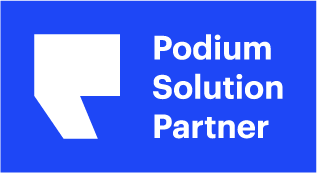Each business, product, and service has a user interface (UI) and results in a user experience (UX), but most people only think of this in terms of a website or app concept. Perhaps the easiest way to explain the difference between the UI and the UX comes down to an app or web design.
UX vs. UI Design
User Interface: The user interface refers to the interactive pieces of the product or service a person uses to fully enjoy the product.
User Experience: The user experience refers to the feelings an individual experiences when using the product or service.
Web Interfaces and App Interfaces
When you visit a website, its web interface (the amalgamation of menus, buttons, content, organization, load time, graphics, photos, videos, etc.) determines the UI. How effective the UI works decides the UX — the user’s experience with the website. If the menu refuses to remain open when the person clicks on it, this creates frustration. That indicates a poor UI and UX. One leads to the other, whether good or bad.
Appropriate design that works well for each individual and allows them to customize the website, app, product, service, etc. to their needs becomes the job of the UX designer. With respect to an app or web interface, this includes items like an easy-to-find button or drop-down menu to translate the page into another language. It includes a responsive design. It also encompasses readability and accessibility, enacting adaptive plug-ins that allow a blind person to use a screen-reader and a hearing-impaired person to read closed captions on every video.
Using one design for all fails because each individual differs. A successful product or service must provide customization. With respect to a website or app, this refers to everything from page load time to font size. Long ago in the 1980s, a UX designer realized it would help people using the then-new personal computers to be able to change the font size. White on a green screen just proved tough to read, especially in a ten-point font.
The Instant Messenger Example
When an app does not load quickly or a website fails to work on mobile and desktop, the UX designer failed at their job. If a message intended for one person in direct communication gets shared with multiple people, the UX designer failed. No one wants their personal messages with their loved ones shared with the masses.
The UI for a messenger, for example, consists of the text editor, its editing ribbon, the buttons for sending or deleting a message, etc. It also consists of the page layout such as where the editor sits on the page. The UX for the messenger refers to each user’s experience. If its code contains an error that causes its messages to get shared publicly rather than privately, the UX designer failed at their job.
A messenger system should provide the ability for every user to send a private message or a public broadcast. While they can choose to make a public message, each user also has the option to disable public broadcasts. The well-designed messenger system lets one user block another user who becomes a pest or behaves abusively. A good UI provides all those options resulting in a positive UX that keeps every user happy. The ability to customize by opting into or out of notifications, broadcast messages, etc. lets each user customize the app’s use to their needs. This produces a positive user experience for all.
UI and UX in Products and Services
Every product or service also has a UX vs UI design and functionality component. The bag of potato chips you purchase from a vending machine or the grocery store has a UI and UX. The design of the bag, its logo, how it presents the nutritional information, the airtightness of the bag design, whether you can reseal it, etc. all contribute to the UI. When you choose from the chips selection, the user experience begins. It continues when you try to open the bag. Have you ever gotten frustrated because a bag refused to tear open? It evidenced poor UI, resulting in a poor UX. The same is true if when you opened the bag, it failed to keep the chips fresh. Stale chips or soggy chips would show a poor UI, resulting in a poor UX. If the bag’s face claimed you could re-seal it using a built-in zip lock, but this failed to work, the faulty re-sealing mechanism shows poor UI design, resulting in a poor UX.
The concepts of UI and UX also refer to service design. Let’s say you own a web design firm, but you only offer full website design. You have a one-size-fits-all package that offers a four-page website. You do not offer an option for updates to existing designs or single page additions or landing pages, etc. Your service design shows a poor user interface. The customer on your website has one choice at a flat rate. They cannot hire you for a couple of hours for an update or to fix a problem with a plug-in. That results in poor UX. Your users probably anticipated they could hire you for updates when they had you design and implement their initial website. They can’t though, and that causes them frustration. It also loses you business.
Regardless of the delivery mechanism, whether a website, app, neural network, freelancer, business, product, or service, each individual using the item or person in question must be able to obtain what they need from them easily without negatively impacting the individual or company. While that may sound complex, it is not.
With respect to a business, it explains why the organization offers phone, email, chatbot, and postal mail contact. The same organization might have individuals who also offer Zoom or Skype meetings. Other individuals might use Telegram or Facebook Messenger. Most businesses now offer multiple social media channels — Facebook, Instagram, Twitter. This lets their customers interact on their chosen social media.
A good user interface in relation to a selection of services offers a number of packages ranging from a one-off purchase to a full-service offering. Continuing the web designer example, a full-service complement would include a full website, single pages, landing pages, updates, etc. The designer would offer both an hourly rate and flat rate packages.
Bake More Pies Can Help
Often, you need an objective opinion in matters of business. Bake More Pies provides that educated, experienced objective opinion. We offer consulting and design services to help you provide the best possible interface to achieve the best possible interaction for a positive user experience.
We can conduct marketing research, identify target audiences and develop target audience profiles for you. Our web designers can create an easy-to-use, intuitive UI for your website, app, product, or service. This makes it simple for each user to access what they need without adversely impacting any other or the product. When you provide a UI each individual can customize to their liking, you produce a positive UX across the board. Each individual has different needs and likes, so you need to create one app or website that each person gets to make their own via settings they choose. Contact Bake More Pies today!



